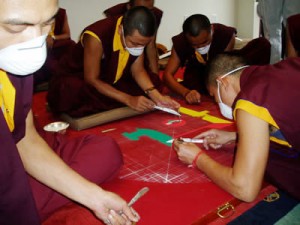
Tibetan Buddhist monks from the Mindrolling monastery in India creating the Red Tara Sand Mandala at ICT’s Washington DC office on September 20, 2005.
Commenting on the significance of the ceremony, Mr. Lodi Gyari, the Dalai Lama’s Special Envoy, said that the “Red Tara is very unique. I thought that it is very important for us to have this, dedicated to His Holiness’ 70th birthday.
“I think by having this wonderful celebration here…I think it is our hope that it will bring peace, stability and a sense of responsibility for all of us.”
The construction of the sand mandala was completed by the monks on Tuesday, September 20th. The Red Tara Puja (Tibetan Buddhist prayer ceremony) took place the next morning. A briefing by Mr. Gyari, started in the evening, followed by a ceremony to dismantle and destroy the sand mandala, as well as a consecration ceremony for the Red Tara Thangka.
Many people in the Washington, DC area, including students from Booker T. Washington High School, as well as members of the Tibetan community, came to observe the two-day event.
The creation, visualization and dismantling of the mandala, which means ‘circle’ in Sanskrit and symbolizes the cycle of life and death, is an integral part of Tibetan Buddhist practice. The destruction symbolizes the impermanence of life.
The iconography of the Red Tara is based on ancient Tibetan Buddhist texts prophesizing the birth of the 14th Dalai Lama and including a special prayer invoking Red Tara to assist the 14th Dalai Lama to overcome extreme external and internal obstacles that could arise in his lifetime. Red Tara, one of the female deities in the Buddhist pantheon, is meditated upon to protect from fear.
Khandro Rinpoche, daughter of Mindrolling Trichen, head of the Nyingma School of Tibetan Buddhism, said that “His Holiness’ efforts cannot be separated from anyone who aspires for peace and harmony in today’s world. The very reason that everyone of us monastics from the east and all of you are gathered here, is because we all aspire not only for understanding our own individual responsibilities but also that there is an inner hope of happiness that we hope to achieve within ourselves as well as share with one another.
“I hope that just as all of the sand grains of the mandala come together, everyone will come together under the leadership of His Holiness, His long life.”
The Dalai Lama’s public talk, “Global Peace Through Compassion,” will be held in Washington, DC on November 13 at the MCI Center.
Biography – Lodi Gyaltsen Gyari (Gyari Rinpoche), Special Envoy to the Dalai Lama
Lodi Gyaltsen Gyari (or Gyari Rinpoche) was born in a nomadic family in Nyarong, Eastern Tibet in 1949 where he received a traditional monastic education after being recognized as a reincarnate lama. As a young boy, Lodi Gyari led his family and many local people into the safety of exile in India in 1959. Realizing that Tibetans need to publicize their struggle to the world he became an editor for the Tibetan Freedom Press and founded the Tibetan Review, the first English language journal published by Tibetans in-exile.
Lodi Gyari was one of the founding members of the Tibetan Youth Congress, an organization of over 10,000 members advocating the independence of Tibet. He served as President of the Congress in 1975. Mr. Gyari was elected to the Assembly of Tibetan People’s Deputies, the Tibetan Parliament in exile, and subsequently became its Chairman.
As the Special Envoy of His Holiness the Dalai Lama, Lodi Gyari is the lead person designated by the Dalai Lama to engage in talks with the Chinese leadership. The latest round of Sino- Tibetan dialogue began in 2002 after a decade of diplomatic stalemate and is regarded by many Tibetans as a historic opportunity to achieve a resolution on the Tibet issue. Mr. Gyari is also the Executive Chairman of the Board of the International Campaign for Tibet, an independent Washington based human rights advocacy group.
Khochhen Rinpoche
Khochhen Rinpoche, was born in 1937 in Eastern Tibet and studied at Mindrolling monastery. Following the Chinese invasion of Tibet in 1949-50, the then 22- year old Rinpoche escaped into exile in India as one of the seven-member entourage of His Holiness Mindrolling Trichen. In 1965, with a small group of monks, he selected a piece of wilderness land near Dehra Dun in India, and transformed it into the monastic seat of Mindrolling in exile, where he is Principal.
Khandro Rinpoche
Khandro Rinpoche is the daughter of Mindrolling Trichen, head of the Nyingma School of Tibetan Buddhism, and one of the most renowned Tibetan lamas currently teaching in the west. Born into the Mindrolling lineage, which throughout its history has had many accomplished female masters, Khandro Rinpoche was recognized at the age of two as the re-incarnation of the Great Dakini of Tsurphu, Khandro Ugyen Tsomo, who was one of the most renowned female masters of her time. Thus, the present Khandro Rinpoche came to hold the lineages of both Nyingma and Kagyu schools.Khandro Rinpoche received teachings and transmissions from some of the most accomplished masters of the 20th century, including the Dalai Lama. She has been teaching internationally for 12 years and teaches extensively in both Europe and North America. She has also established and heads the Samten Tse Retreat Centre in Mussoori, India which provides a place of study and retreat for monastics and western lay practitioners, with students from East and West.

